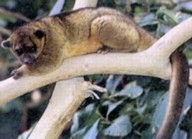

Genus:
Potos
Species: flavus

Fifty degrees North to fifteen degrees South, and thirty-five degrees to sixty-five degrees in the Amazon Rainforest lives a mammal called the kinkajou. The kinkajou mostly sleeps in the upper canopy, hiding in the holes of the trees during the day napping. It's a cute little animal with the body grows from 16 to 30 inches; its tail grows from 15 to 33 inches. Its shoulder height is up to 10 inches and it weights 3 to 10 pounds. The Kinkajou has a nice slim body with a full coat of golden-brown fur. Its face is so cute; it has a round head with big eyes, its small ears stick out of their heads and their muzzle looks like a bears snout. The soles of the kinkajou's hind feet provide a firm grip while it climbs. The way it moves is mostly by climbing and jumping.
The sexual maturity for the male is 1.5 years and the female is 2.25 years. The mating season is year round. The gestation period is 112 to 118 days. The number of youths a female has is 1, rarely 2 babies. When a baby is born it weighs 5 to 7 ounces. The color of their fur is silver-gray and they have dark tips on their ears. Their ears open up after 5 days and their eyes are closed for two weeks. They don't do anything except griping trees with their tails, but they're very weak. They depend on their parents for a month to a month and a half. The baby is carried on the mother's belly and their mother protects her baby(s). The birth interval is 1 year.
The kinkajou is a solitary animal, which mostly travels alone. They don't travel in groups. Their lifespan is over 23 years. It's an omnivore and its typical diet is fruit, nectar, honey and insects. The kinkajou name came from the Indians, meaning " Honey Bear " because they love honey so much. Their prey is insects, birds, and small mammals. Predators to the kinkajou are people, big cats and birds of prey.
The adaptation, sharp claws help them to climb trees and their long tail to hang from tree to tree for their grip. Kinkajous' teeth are good for eating big food and ripping apart its food. They also hide in the upper branches from the birds of prey. It benefits from its environment by feeding on insects such as termites.
They are not endangered because people rarely see them. They sleep during the day and only come out at night. They don't travel in packs, they travel alone therefore it's hard to find one kinkajou at a time. Living in the thick vine tree and not coming out until night protects it.
The Amazon is a tropical rainforest. Each year the Amazon Rainforest gets about 9 feet of rain. During the months of maximum precipitation, broad areas traversed by the Amazon are subject to severe floods. The Amazon contains more species of fauna and flora than any other ecosystem in the world. Also, the Amazon basin covers more than 2.5 million square miles more than any other rainforest.
It's related to the raccoon family and the mountain coati. Where the kinkajou lives in the Amazon rainforest is very beautiful, but the Amazon is being cleared at an alarming rate for timber and agricultural purposes.
By Danielle Fogg, 2003
Bibliography:
"Kinkajou" card 259. Wildlife Explorer, International Master Publishers AB, U.S.A
"Kinkajou" Book of Mammals 1981
"Amazon Rainforest"
1993-2002
http://encarta.msn.com/encnet/refpages/RefMedia.aspx?refid=
461526714
( January 6,
2003)
Amazon (river)
1993-2000
http://encarta.msn.com/encnet/refArticle.aspx?761571466¶=3
(January
6,2003)
"How rainy is the
Rainforest?" 1996
http://www.eduwe.com/rain/rainforest.html
(December 11, 2002)
"Kinkajou"
http://Isb.syr.edu/project/cyberzoo/kinkajou.html
(January 5,2003)
"Kinkajou"
http://www.animalsotherrainforest.org/kinkajou.htm
(December 11,2002)
"The Kinkajou"
http://www.seattleschools.org/schools/bfday/student_webs/Ashley/
The%20Kinkajou.htm
(January 5,2003)
"Where's the
Amazon"
http://www.eduweb.com/rainforest/worldmap.html
(January 6,2003)